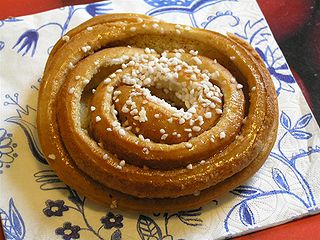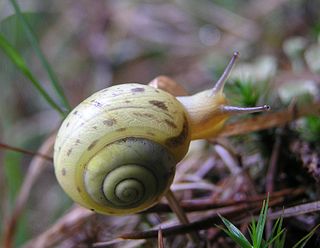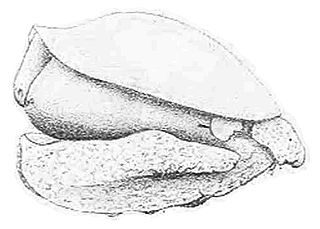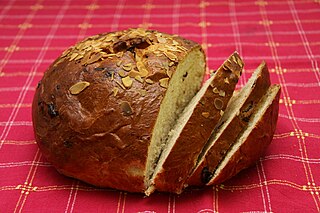
A semla, vastlakukkel, laskiaispulla, Swedish eclair, fastlagsbulle/fastelavnsbolle or vēja kūkas is a traditional sweet roll made in various forms in Sweden, Finland, Norway, Denmark, the Faroe Islands, Iceland, Estonia, and Latvia, associated with Lent and especially Shrove Tuesday in most countries, Shrove Monday in Denmark, parts of southern Sweden, Iceland and Faroe Islands or Sunday of Fastelavn in Norway. In Sweden it is most commonly known as just semla, but is also known as fettisdagsbulle, lit. 'Fat Tuesday bun' or 'Shrove Tuesday bun'. In the southern parts of Sweden, as well as in Swedish-speaking Finland, it is known as fastlagsbulle. In Estonia it is called vastlakukkel. In Norway and Denmark it is called fastelavnsbolle. In Iceland, it is known as a bolla and served on Bolludagur. In Faroe Islands it is called Føstulávintsbolli, and is served on Føstulávintsmánadagur. In Latvia, it is called vēja kūkas. Semla served in a bowl of hot milk is hetvägg.

Karl Hermann Johannes Thiele was a German zoologist specialized in malacology. Thiele was born in Goldap, East Prussia. His Handbuch der systematischen Weichtierkunde is a standard work. From 1904 until his retirement in 1925 he was the curator of the malacological collection at the Museum für Naturkunde in Berlin. Thiele described more than 1.500 new species of molluscs; until today their types are deposited with the Museum of Natural History in Berlin. Especially important are his works on the Mollusca of the First German Antarctica Expedition and of the German Deep Sea Expedition aboard the vessel Valdivia.

A cinnamon roll is a sweet roll commonly served in Northern Europe and North America. In Sweden it is called kanelbulle, in Denmark it is known as kanelsnegl, in Norway it is known as kanelbolle, skillingsbolle or kanelsnurr, in Finland it is known as korvapuusti, in Iceland it is known as kanilsnúður, and in Estonia it is known as kaneelirull. In Austria and Germany, it is called Zimtschnecke.

Sticky buns are a type of dessert or breakfast sweet roll that generally consist of rolled pieces of leavened dough — sometimes containing brown sugar or cinnamon — compressed together to form a kind of flat loaf corresponding to the size of the pan in which they are to be baked. Before the dough is placed in the baking-pan, the latter is lined with the "sticky" ingredients, such as brown sugar or honey, as well as nuts and raisins and perhaps more sugar and sometimes butter. After the buns are baked, they are inverted so that the pan lining then becomes a topping. Commercially produced sticky buns, however, are usually just baked in an aluminum loaf tin, which allows the topping to suffuse the buns, making them sticky throughout. The way the buns were baked allows them to more or less be pulled off as individual servings, although it is often a futile effort.

A saffron bun, Cornishtea treat bun or revel bun, is a rich, spiced yeast-leavened sweet bun that is flavoured with saffron and contains dried fruit including currants and raisins similar to a teacake. The main ingredients are plain flour, butter, yeast, caster sugar, currants and sultanas. Larger versions baked in a loaf tin are known as saffron cake.

Cozonac or Kozunak is a sweet yeast dough that can be used to make different traditional holiday breads and cakes. Often mixed with raisins, it can be baked as a loaf or rolled out with fillings like poppy seed or walnuts. It is common throughout Southeastern Europe, Romania, Bulgaria and Serbia, North Macedonia, Greece, etc. Rich in eggs, milk and butter, it is usually prepared for Easter in Romania, Serbia, Bulgaria, and in Romania and Moldova it is also traditional for Good Friday. The name comes from the Bulgarian word for hair-коса/kosa, or Greek: κοσωνάκι, romanized: kosōnáki, a diminutive form of κοσώνα, kosṓna.

Fruticicola fruticum is a species of medium-sized, air-breathing land snail, a terrestrial pulmonate gastropod mollusc in the family Camaenidae.
Franz Hermann Troschel was a German zoologist born in Spandau.

Christian Ernst Stahl was a German botanist who was a native of Schiltigheim, Alsace.

Franz Martin Hilgendorf was a German zoologist and paleontologist. Hilgendorf's research on fossil snails from the Steinheim crater in the early 1860s became a palaeontological evidence for the theory of evolution published by Charles Darwin in 1859.

Lophopleurella capensis is a species of sea snail, a marine gastropod mollusk in the family Oxynoidae.
Neactaeonina is a genus of small sea snails, predatory marine gastropod molluscs in the family Acteonidae, the barrel bubble snails.

Pain aux raisins, also called escargot or pain russe, is a spiral pastry often eaten for breakfast in France. Its names translate as "raisin bread", "snail" and "Russian bread" respectively. It is a member of the pâtisserieviennoise family of baked foods.
Chloritis balatensis is a species of air-breathing land snail, a terrestrial pulmonate gastropod mollusk in the family Camaenidae.
Chloritis talabensis is a species of air-breathing land snail, a terrestrial pulmonate gastropod mollusk in the family Camaenidae.

Onoba semicostata is a species of minute sea snail, a marine gastropod mollusk or micromollusk in the family Rissoidae.

Bún ốc is a Vietnamese dish originating from Hanoi, Vietnam. Roasted or boiled snails, may be eaten first as an appetizer. Snail congee is called cháo ốc, and canh ốc chuối đậu, is a thin snail soup with green banana, fried tofu and tía tô.

A Heißwecke, HICE-veck-ə,, also called a Heißewecke or Hedewig, is a traditional type of currant bun within the German-speaking region of Europe that goes back to at least to the Late Middle Ages. In North and Northwest Germany it is eaten before the beginning of the pre-Easter fasting period known as Lent, especially from Rose Monday (Rosenmontag) to Ash Wednesday (Aschermittwoch). It is a sweet bread roll made with milk and wheat flour that is eaten hot, hence the name: Heißwecken literally means "hot rolls". Heißwecken are predominantly eaten in the area influenced by the Hanseatic League i.e. most of northern Europe from what is now the Netherlands to Poland and the Baltic Sea coast. It has numerous dialectical names that are almost all derived from the term Heißwecken. The most common are Hedewäggen, Hetwegge, Heiteweggen and Heetwich.
Otto Wilhelm Hermann Reinhardt was a German botanist and conchologist. He was a teacher at a trade school in Berlin. Reinhardt was a friend of Paul Friedrich August Ascherson and co-founder of the botanical society in Brandenburg province.















